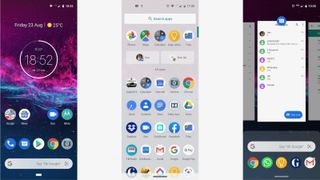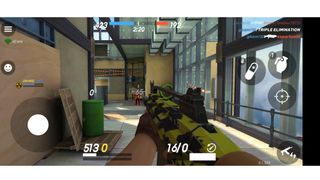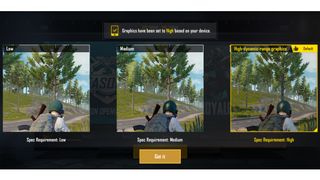Why you can trust TechRadar
Interface and reliability
- Excellent Android One version of Android 9 Pie
- Still get limited Moto Display and Moto Actions
In case we haven’t made it abundantly clear by now, we’re massive fans of the Android One OS that sits at the heart of the Motorola One Action. This is Google’s near-stock version of what is currently Android 9 Pie, with absolutely no manufacturer modifications to its appearance or core functions.
Of course, Motorola has never been the worst offender on the OS tinkering front. Quite the opposite, in fact. But what Android One brings is the cast iron guarantee of software updates for at least two years, meaning the One Action will definitely get Android 10 and 11.
It’s also guaranteed to get security upgrades for the next three years. In other words, this is as safe a bet as you’re going to get in the constantly shifting world of Android smartphones.

Assurances aside, this pure take on Android 9 Pie is a pleasure to use. We’ve already mentioned the delights of a cohesive UI and of being able to rely on Google’s stock apps alone. But it also offers an appreciably zippy, stutter-free navigation experience on the One Action.
Part of that is down to competent hardware, of course. But Android One deserves its fair share of credit.
There are still little flecks of Motorola’s own personality in this OS too. You get the signature Moto home screen widget by default, which provides time, date, weather and battery info in one handy circular cluster.
We’re not 100% sold on Motorola’s current gesture implementation though. And given that it’s an option that needs to be activated here, it seems neither is Motorola. But it’s quite usable if you give it time.

With this option activated, tapping the bar at the bottom takes you home. Tapping and swiping left backs up, while tapping and swiping right flicks to the previous opened app. Tapping and swiping up brings up the app switcher, while an extended swipe brings up the app tray.
It’s possible to opt for the classic 3-button approach or Google’s own lighter Android gesture implementation in the Settings menu, if either of these suits you better.
You also get a few Moto Actions, like a reliable shortcut to the camera app by double-twisting the handset, or to the torch by double-chopping it. Moto Display is here too, giving you control over lock screen notifications and the ability to keep the phone awake while you’re looking at it.
Less welcome are Motorola’s horrible default message and ring tones. But everyone changes those things early on anyway, right?
Movies, music and gaming
- Limited support for super-wide 21:9 screen
- Generous 128GB of storage and microSD
The Motorola One Action’s 21:9 display makes it an interesting device for media playback, but it’s not a total success.
We’re not entirely sure there’s enough of a payoff for this somewhat awkward form factor. The vast majority of video content on the internet or from streaming services is shot in a narrower aspect ratio, which means you’ll frequently encounter thick black side borders on landscape content.
You can pinch to zoom in with a lot of this content, but that tends to lop off large sections of the top and bottom.

The amount of content that’s shot in 21:9 is steadily on the rise. Netflix reckons that two-thirds of its original movie content is shot in this format, for example.
However, we noticed that even home-brewed films like Birdbox took on a slightly lopsided appearance on the One Action, with the video being shunted to the side to try and avoid the punch-hole camera. Sticklers for symmetry should avert their eyes.
You might expect gaming content to fill out the horizontal space a little better, and it does - provided you don’t opt for that Moto gesture bar control option. Do that and some games (including Guns of Boom and Arena of Valor) will leave an ugly border where the virtual home bar is.

While we’re on the subject of gaming, the Motorola One Action makes do with a single speaker on the bottom of the device. It’s far from ideal, but at least there’s a headphone socket.
Sticking with the positives, 128GB is plenty of storage for games, video and other media. It’s especially good given the One Action’s affordable price tag, and you can also add up to 512GB of additional storage via the included microSD slot.
Then there’s the simple fact that games run really well on the Motorola One Action. You can thank its decent internal hardware for that.
Specs and benchmark performance
- Samsung Exynos 9609 with 4GB of RAM yields strong performance
- Fluid gaming performance and impressive benchmarks at the price
The Motorola One Vision was the first phone to use Samsung’s Exynos 9609 chipset, and it’s not a great surprise to find that the Motorola One Action follows suit.
Ably supported by 4GB of RAM, this is a fine performer at the price. It even earns its Action name by being a capable gaming machine.

PUBG Mobile defaults to High HDR settings upon boot-up, and proceeds to run very fluidly. Guns of Boom, meanwhile, can be whacked up to 60fps without any obvious hit to performance.
Our Geekbench 4 benchmarks followed closely in line with what we experienced on the One Vision. Given the nigh-on identical hardware involved, that’s to be expected.

An average multi-core score of 5,369 is really strong, comfortably trumping the Moto G7 Plus’s 4,877 and more or less matching the Honor 20 Lite’s 5,404.
We partially attributed the fluid experience of using the Motorola One Action to Android One, but this rock solid hardware is another part of the equation. We didn’t experience any stutters or halts during general navigation, while the gestural camera shortcut boots up quite quickly (if not instantaneously).
Current page: Anything else I should know?
Prev Page Battery life and camera Next Page Verdict and competition
